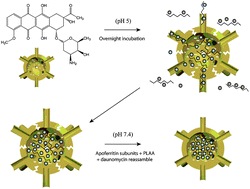Apoferritin-based nanomedicine platform for drug delivery: equilibrium binding study of daunomycin with DNA
Abstract
This paper describes the preparation and optimization of the analytical properties of the

* Corresponding authors
a U.S. Customs and Border Protection, New York Laboratory, 1100 Raymond Blvd., Newark, New Jersey, USA
b
Pacific Northwest National Laboratory, Richland, Washington, USA
E-mail:
yuehe.lin@pnl.gov
Fax: +01-509-376-5106
Tel: +01-509-371-6241
This paper describes the preparation and optimization of the analytical properties of the

 Please wait while we load your content...
Something went wrong. Try again?
Please wait while we load your content...
Something went wrong. Try again?
A. Ma-Ham, H. Wu, J. Wang, X. Kang, Y. Zhang and Y. Lin, J. Mater. Chem., 2011, 21, 8700 DOI: 10.1039/C0JM04321D
To request permission to reproduce material from this article, please go to the Copyright Clearance Center request page.
If you are an author contributing to an RSC publication, you do not need to request permission provided correct acknowledgement is given.
If you are the author of this article, you do not need to request permission to reproduce figures and diagrams provided correct acknowledgement is given. If you want to reproduce the whole article in a third-party publication (excluding your thesis/dissertation for which permission is not required) please go to the Copyright Clearance Center request page.
Read more about how to correctly acknowledge RSC content.
 Fetching data from CrossRef.
Fetching data from CrossRef.
This may take some time to load.
Loading related content
